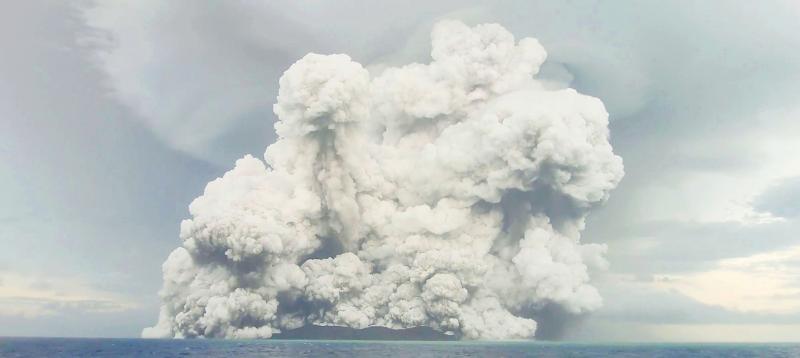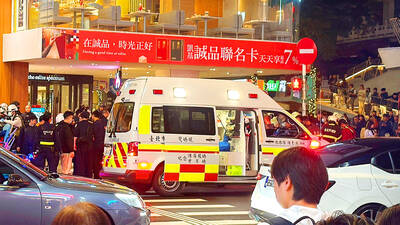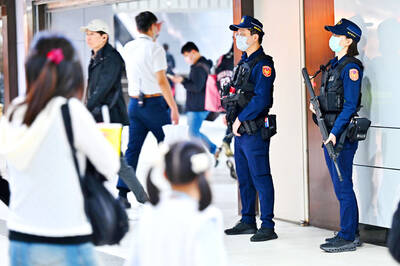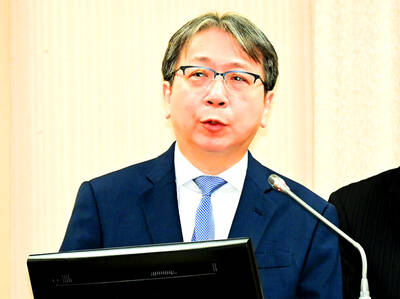New Zealand and Australia yesterday sent military surveillance flights to Tonga to assess the damage a huge undersea volcanic eruption left in the Pacific island nation.
A towering ash cloud since Saturday’s eruption had prevented earlier flights.
New Zealand hopes to send essential supplies, including much-needed drinking water, on a military transport plane today.

Photo: Tonga Geological Services / Reuters
No casualties have been confirmed on Tonga, although a British woman was reported missing.
The British Foreign Office yesterday said it was “supporting the family of a British woman reported missing in Tonga and are in contact with the local authorities.”
Relatives of Angela Glover, who ran an animal rescue center in Tonga’s capital, said she has not been seen since she was swept away by a tsunami wave. Her husband, James, survived by clinging on to a tree.
Angela Glover’s brother Nick Eleini told the Guardian: “I don’t think this is going to have a happy ending.”
Communications with Tonga remained extremely limited. The company that owns the single underwater fiber-optic cable that connects the island nation to the rest of the world said it was likely severed in the eruption and repairs could take weeks.
The loss of the cable leaves most Tongans unable to use the Internet or make telephone calls abroad. Those that have managed to get messages out described their nation as looking like a moonscape as they began cleaning up from the tsunami and falling volcanic ash.
Tsunami waves of about 80cm crashed into Tonga’s shoreline, and New Zealand Prime Minister Jacinda Ardern described damage to boats and shops on Tonga’s shoreline.
The waves crossed the Pacific, drowning two people in Peru and causing minor damage from New Zealand to Santa Cruz, California.
Scientists said they did not think the eruption would have a significant impact on the climate.
Huge volcanic eruptions can sometimes cause temporary global cooling as sulfur dioxide is pumped into the stratosphere, but in the case of the Tonga eruption, initial satellite measurements indicated the amount of sulfur dioxide released would only have a tiny effect of perhaps 0.01°C global average cooling, said Alan Robock, a professor at Rutgers University in New Jersey.
Satellite images showed the spectacular undersea eruption, with a plume of ash, steam and gas rising like a giant mushroom above the Pacific.
A sonic boom could be heard as far away as Alaska and sent pressure shock waves around the planet twice, altering atmospheric pressure that might have briefly helped clear the fog in Seattle, the US National Weather Service said.
Large waves were detected as far away as the Caribbean due to pressure changes generated.
Ardern said the capital, Nuku’alofa, was covered in a thick film of volcanic dust, contaminating water supplies and making fresh water a vital need.
Aid agencies said that thick ash and smoke had prompted authorities to ask people to wear masks and drink bottled water.
In a video on Facebook, Nightingale Filihia was sheltering at her family’s home from a rain of volcanic ash and tiny pieces of rock that turned the sky pitch black.
“It’s really bad. They told us to stay indoors and cover our doors and windows because it’s dangerous,” she said. “I felt sorry for the people. Everyone just froze when the explosion happened. We rushed home.”
Outside the house, people were seen carrying umbrellas for protection.

TRAGEDY STRIKES TAIPEI: The suspect died after falling off a building after he threw smoke grenades into Taipei Main Station and went on a killing spree in Zhongshan A 27-year-old suspect allegedly threw smoke grenades in Taipei Main Station and then proceeded to Zhongshan MRT Station in a random killing spree that resulted in the death of the suspect and two other civilians, and seven injured, including one in critical condition, as of press time last night. The suspect, identified as a man surnamed Chang Wen (張文), allegedly began the attack at Taipei Main Station, the Taipei Fire Department said, adding that it received a report at 5:24pm that smoke grenades had been thrown in the station. One man in his 50s was rushed to hospital after a cardiac arrest

PUBLIC SAFETY: The premier said that security would be tightened in transport hubs, while President Lai commended the public for their bravery The government is to deploy more police, including rapid response units, in crowded public areas to ensure a swift response to any threats, President William Lai (賴清德) said yesterday after a knife attack killed three people and injured 11 in Taipei the previous day. Lai made the remarks following a briefing by the National Police Agency on the progress of the investigation, saying that the attack underscored the importance of cooperation in public security between the central and local governments. The attack unfolded in the early evening on Friday around Taipei Main Station’s M7 exit and later near the Taipei MRT’s Zhongshan

SAFETY FIRST: Double the number of police were deployed at the Taipei Marathon, while other cities released plans to bolster public event safety Authorities across Taiwan have stepped up security measures ahead of Christmas and New Year events, following a knife and smoke bomb attack in Taipei on Friday that left four people dead and 11 injured. In a bid to prevent potential copycat incidents, police deployments have been expanded for large gatherings, transport hubs, and other crowded public spaces, according to official statements from police and city authorities. Taipei Mayor Chiang Wan-an (蔣萬安) said the city has “comprehensively raised security readiness” in crowded areas, increased police deployments with armed officers, and intensified patrols during weekends and nighttime hours. For large-scale events, security checkpoints and explosives

ON ALERT: Taiwan’s partners would issue warnings if China attempted to use Interpol to target Taiwanese, and the global body has mechanisms to prevent it, an official said China has stationed two to four people specializing in Taiwan affairs at its embassies in several democratic countries to monitor and harass Taiwanese, actions that the host nations would not tolerate, National Security Bureau (NSB) Director-General Tsai Ming-yen (蔡明彥) said yesterday. Tsai made the comments at a meeting of the legislature’s Foreign Affairs and National Defense Committee, which asked him and Minister of National Defense Wellington Koo (顧立雄) to report on potential conflicts in the Taiwan Strait and military preparedness. Democratic Progressive Party (DPP) Legislator Michelle Lin (林楚茵) expressed concern that Beijing has posted personnel from China’s Taiwan Affairs Office to its